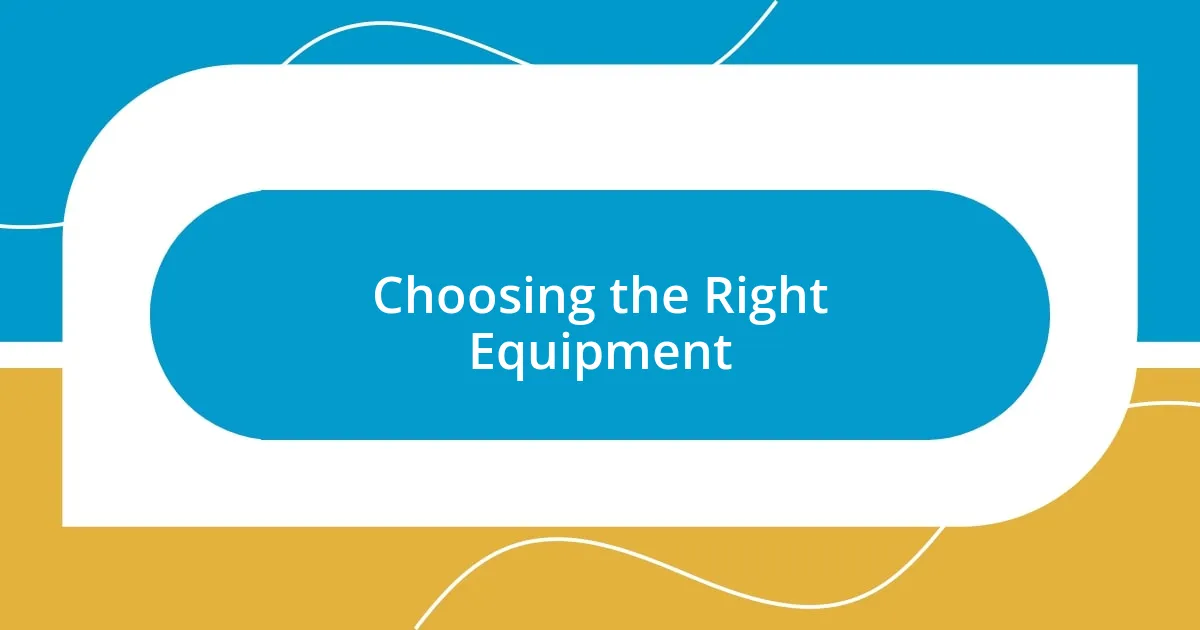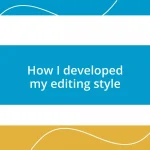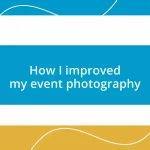Key takeaways:
- Angles play a crucial role in geometry and have real-world applications in design, sports, and art.
- Choosing the right equipment, such as quality protractors and set squares, enhances creativity and precision in working with angles.
- Experimenting with different shooting angles and natural light can dramatically change the emotional impact of photographs.
- Sharing and analyzing work through feedback fosters growth and inspires new creative directions in photography.

Understanding the Basics of Angles
Angles are fascinating components of geometry that define the space between two intersecting lines. I remember the first time I truly grasped this concept in school; it was like a light bulb switching on. Suddenly, I could see angles everywhere—in the corners of a room, the way streets intersect, and even in my favorite paintings. Isn’t it amazing how something so simple can reveal such complexity in the world around us?
When we talk about angles, we often think of their types: acute, obtuse, right, straight, and reflex. I had an epiphany while practicing with a protractor. Understanding the difference between an acute angle and an obtuse one felt empowering. It’s like learning to differentiate between flavors in a dish. Have you ever stopped to think about how these angles help us create structures, design art, and even play sports? They’re not just abstract ideas; they have real-world implications.
Moreover, the measurements of angles, typically expressed in degrees, help us communicate complex ideas in a straightforward manner. I often find myself sketching diagrams to bring my thoughts to life, showing the precise angles I envision in my designs. Have you tried visualizing angles when working on your projects? The clarity it brings is invaluable, allowing you to see the connections and relationships between different elements.

Choosing the Right Equipment
Choosing the right equipment can significantly enhance how you experiment with angles. I remember the excitement when I first purchased a good quality protractor and a set square; it felt like unlocking a new level in my creativity. Having tools that offer precision makes all the difference, ensuring that I can trust my measurements and focus on my artistic vision rather than grappling with inaccuracies.
When selecting tools, consider the following options:
- Protractor: Ensure it’s well-marked and easy to read.
- Set Squares: Look for different angles; having a 30-60-90 and a 45-degree triangle can expand your possibilities.
- Angle Ruler: A flexible angle ruler can be helpful for more complex shapes.
- Drafting Software: If you’re experimenting digitally, invest in software that allows for accurate angle measurements.
The right equipment can transform your experience, turning a daunting task into a seamless flow of creativity. I find that even a simple tool like a compass can help me understand relationships between angles, bringing a new dimension to my work. The joy is in discovering how each tool can help me approach angles differently, revealing layers I hadn’t considered before.

Exploring Different Shooting Angles
Exploring different shooting angles can truly elevate the way we perceive a subject. I still remember the thrill of experimenting with a lower angle while photographing a small flower in my garden. The way the petals stretched towards the sky felt almost heroic, capturing a perspective that I had never appreciated before. That shift in viewpoint made me realize how angles can transform ordinary moments into extraordinary visuals.
It’s fascinating to think about how different angles can convey various emotions and narratives. For a dramatic effect, I’ve played with high angles that create an impression of vulnerability. This technique always gives me that “aha!” moment, as the captured image can evoke a sense of intimacy, almost like a secret we’re sharing with the viewer. Have you tried shooting from angles that make your subject feel larger than life? It’s like discovering hidden pathways into your subject’s story.
I’ve also found that experimenting with angles isn’t just about aesthetics; it’s a dance between light and shadow as well. A slight tilt can dramatically change the mood of a photo. Once, I angled my camera to capture a sunset behind silhouetted trees, and the result was breathtaking. This experience reinforced my belief that angles are not merely technical choices; they’re the magic brushes we wield to paint the feelings we want to evoke.
| Angle Type | Description |
|---|---|
| High Angle | A view from above, creating a sense of vulnerability. |
| Low Angle | Shooting from below, giving a grander perspective to the subject. |
| Eye Level | A neutral angle that presents the subject as it naturally appears. |
| Bird’s Eye View | An overhead perspective, fantastic for capturing patterns or layouts. |

Using Natural Light Effectively
When it comes to using natural light effectively, I’ve discovered that timing truly is everything. I often find myself chasing the golden hour — that magical period just after sunrise or before sunset — when the light has this warm, soft quality that transforms everything it touches. It was during one early morning walk that I noticed how the sun hitting the dew on blades of grass created a sparkly effect, turning an everyday scene into something almost magical. Have you ever noticed how the world seems to glow at those moments?
Understanding how light changes throughout the day helps me plan my shoots. I remember a time I was capturing portraits in my backyard around noon. The harsh overhead sunlight created unflattering shadows on my subject’s face, and I felt frustrated. It was only later, when I returned in the late afternoon with the sun at a different angle, that my images began to come alive. The glow from the sunlight added warmth and depth, revealing the emotion I wanted to capture. Isn’t it incredible how light can tell a story of its own?
I also love experimenting with natural light indoors, particularly when using windows as a source. Early one evening, I set up a scene with a simple vase of flowers on a table by the window. The way the sunlight streamed in created beautiful highlights and shadows, emphasizing the delicate textures of the petals. It made me realize how a simple setup could become striking with thoughtful placement and the right light. Have you tried selecting your shooting location based on natural light sources? It can really elevate your work.

Incorporating Composition Techniques
Incorporating composition techniques into your photography journey can be a game-changer. Sometimes, I find that applying the rule of thirds helps to create a more balanced and engaging image. I remember capturing a bustling street scene where placing the subject off-center drew the viewer’s eye straight into the heart of the activity. It made that photo feel alive, almost as if the viewer was part of the unfolding story. Have you ever noticed how positioning can change the entire narrative of your image?
Another technique I gravitate towards is leading lines. They guide the viewer’s gaze through the photograph, creating a natural sense of movement. On one of my hikes, I stumbled upon a winding path through the woods. By positioning my camera low and using the path as a leading line, it felt as though I was inviting the viewer to step into that serene place alongside me. This simple adjustment in composition transformed my snapshot into an inviting journey—how often do we overlook the power of such natural cues?
I also find that incorporating negative space can breathe life into a composition. One day, while photographing a solitary tree against a vast sky, I intentionally left a lot of empty space around it. The simplicity of that layout highlighted the beauty of isolation and fostered an emotional response. Sometimes, less really is more, don’t you agree? Choosing how much to include in the frame can articulate a story that resonates deeply with the viewer, opening up a conversation between the photograph and its audience.

Editing for Angle Enhancement
Editing my photos for angle enhancement has become an exciting part of my creative process. I remember one specific instance where I shot a beautiful landscape, but the image felt flat despite the vibrant colors. I decided to adjust the perspective with editing software to emphasize the foreground elements, adding depth to the image. It was like unlocking a hidden layer in my photograph! Have you ever felt that thrill when a simple edit transforms a lackluster photo into something compelling?
One fundamental aspect of angle enhancement in editing is adjusting the crop. I typically experiment with different crops to see how they shift the viewer’s focus. I once had a photo of a mountain range that I loved, but it didn’t quite resonate until I zoomed in on a single peak framed by the clouds. That subtle change in angle revealed the majestic beauty of nature in a whole new light. Isn’t it amazing how a small tweak can change the story a photo tells?
In my journey, I’ve also discovered the power of playing with perspective in post-processing. For instance, on a whim, I merged two shots from a bustling cityscape to construct a panoramic view. This not only allowed me to showcase the symphony of urban life but also altered the angle to create a sense of grandeur that was missing before. Have you thought about how merging different perspectives can create a dynamic narrative in your photos? It’s not just about capturing angles but about painting a vivid story that invites viewers in.

Sharing and Analyzing Your Work
Sharing my photography work has always felt like inviting someone into my creative world. I often post my images on social media and seek feedback from fellow photographers. I remember receiving a comment on a shot I took of a bustling market—someone pointed out how the lighting could be improved to emphasize the shadows. That insight pushed me to rethink not only that particular shot but also how I approach lighting in future projects. Have you ever taken a viewer’s feedback and had it completely reshape your perspective?
Analyzing my work, whether through self-reflection or engaging with critiques, invites deeper understanding. I like to dissect my favorite photos by considering what elements made them successful. For instance, there was a time I captured a sunset reflected in a lake. Reflecting back on the process, I realized that the angle I chose allowed the colors to dance across the water beautifully. This kind of analysis not only sharpens my skills but sparks inspiration for new projects. How often do you take the time to evaluate your own artistry?
I also find immense value in sharing my progress on platforms designed for photographers. Recently, I joined a forum where members post their images for group critiques. I shared a series of experimental shots of architecture, playing with unusual perspectives. The feedback was enlightening; many suggested focusing on symmetry to enhance the visual appeal. This experience reminded me that sharing isn’t just about showcasing what we’ve achieved; it’s a collaborative journey towards growth. What if every comment or critique was seen as an invitation to expand our creative horizons?














